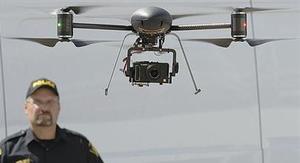Law enforcement technologyCanadian police push limits of civilian UAVs laws
A local police department in Ontario, Canada is exploring the use of small unmanned aerial vehicles (UAVs) and pioneering civil aviation laws for future use of these aerial drones; in 2007 the Kenora Police Department set a new precedence when photographs of a homicide scene, taken from a UAV, were admitted as evidence in a trial for the first time; unlike the large drones used in Afghanistan these smaller UAVs are not practical for surveillance and are primarily used to record photos for trials and provide aerial reconnaissance in hostage situations or bomb threats; the small UAVs are equipped with several cameras including digital still, video, and Forward Looking Infrared (FLIR) camera; the Canadian government is working on developing regulations for the use of these UAVs in civilian airspace

Ontario Provincial Police UAV with camera mounted // Source: aticourses.com
A local police department in Ontario, Canada is exploring the use of small unmanned aerial vehicles (UAVs) and pioneering civil aviation laws for future use of these aerial drones.
Ontario Provincial Police Constable Marc Sharpe has been flying various custom built fixed wing and commercially available rotary wing UAVs to photograph crime scenes and highway accidents as a cheaper alternative to airplanes or helicopters. In 2007 Sharpe set a new precedent when his photographs of a homicide scene, taken from a UAV for the Kenora Police Department, were admitted as evidence in a trial for the first time.
Constable Sharpe began by using custom built fixed wing UAVs that he created himself, but has since switched to using commercially made miniature helicopters. He currently flies the X-6 made Draganfly Systems and the Scout designed by Aeryon Labs Inc., both manufactured by Canadian firms.
These new UAVs are superior to his original designs as they are able to take off and land vertically, require less area to operate, and can hover over fixed areas. Manual controls are also supplemented by GPS and computerized controls that help fly the aircraft.
The small UAVs are equipped with several cameras including digital still, video, and Forward Looking Infrared (FLIR) cameras. Image quality is also much higher as cameras include vibration dampeners and image stabilization technology.
Unlike the large drones used in Afghanistan, these smaller UAVs are not practical for surveillance. Instead, they are primarily used to record photos for trials and provide aerial reconnaissance in hostage situations or bomb threats.
Flights usually last five to fifteen minutes and require three man teams consisting of a pilot, camera operator, and an aviation safety officer. Radio controlled UAVs are also restricted to line of sight flights and maximum altitude of 400 feet due to Canada’s aviation safety laws.
Current laws only allow pilots to fly their radio controlled model aircraft in designated locations, but Transport Canada, the government body that regulates airspace, classifies these UAVs as Unmanned Aerial Systems (UAS) which exempts them from such laws.
Sharpe explains, “According to regulations it’s not a model aircraft, it is an aircraft and we have to follow the rules that apply to aircraft.”
“The rules are designed around having as safe an operation as possible.”
Constable Sharpe is currently working with Transport Canada to develop regulations for the use of these UAVs in civilian air space.
“Currently there is no legislation governing UAVs in controlled civilian air space,” Sharpe said. “There’s a big future for UASs and the government is trying to figure out how to integrate them into civilian air space.”
Starting in November of last year, UAVs have been operating under a Special Flight Operations Certificate which allows it to fly over urban areas. The certificate must be renewed annually with Transport Canada.
According to Sharpe, “Kenora was the first use of an UAV in civilian airspace within an urban environment in North America,” and “the Draganfly was the first commercial system of its kind to be used in an urban environment.”
